The Aesthetics and Pragmatics of Symmetry in High-Gain and Wideband Circularly Polarized Antenna Design
Abstract
:1. Introduction
2. Antenna Design
2.1. Antenna Configuration
2.2. Step-by-Step Design Process
2.3. Surface Current Analysis
2.4. Antenna Parameter Analysis
3. Experiment Results
4. Conclusions
Author Contributions
Funding
Data Availability Statement
Conflicts of Interest
References
- Chen, H.M.; Wang, Y.K.; Lin, Y.F.; Lin, C.Y.; Pan, S.C. Microstrip-Fed Circularly Polarized Square-Ring Patch Antenna for GPS Applications. IEEE Trans. Antennas Propag. 2009, 4, 1264–1267. [Google Scholar] [CrossRef]
- Tan, M.T.; Wang, B.Z. A Dual-Band Circularly Polarized Planar Monopole Antenna for WLAN/Wi-Fi Applications. IEEE Antennas Wirel. Propag. Lett. 2016, 15, 670–673. [Google Scholar] [CrossRef]
- Narbudowicz, A.; John, M.; Sipal, V.; Bao, X.; Ammann, M.J. Design Method for Wideband Circularly Polarized Slot Antennas. IEEE Trans. Antennas Propag. 2015, 10, 4271–4279. [Google Scholar] [CrossRef]
- Ge, L.; Li, M.; Li, Y.; Wong, H.; Luk, K.M. Linearly Polarized and Circularly Polarized Wideband Dipole Antennas With Reconfigurable Beam Direction. IEEE Trans. Antennas Propag. 2018, 4, 1747–1755. [Google Scholar] [CrossRef]
- Hasani, H.; Silva, J.S.; Capdevila, S.; García-Vigueras, M.; Mosig, J.R. Dual-Band Circularly Polarized Transmitarray Antenna for Satellite Communications at (20, 30) GHz. IEEE Trans. Antennas Propag. 2019, 8, 5325–5333. [Google Scholar] [CrossRef]
- So, K.K.; Wong, H.; Luk, K.M.; Chan, C.H. Miniaturized Circularly Polarized Patch Antenna With Low Back Radiation for GPS Satellite Communications. IEEE Trans. Antennas Propag. 2015, 12, 5934–5938. [Google Scholar] [CrossRef]
- Lin, Q.W.; Wong, H.; Zhang, X.Y.; Lai, H.W. Printed Meandering Probe-Fed Circularly Polarized Patch Antenna with Wide Bandwidth. IEEE Antennas Wirel. Propag. Lett. 2014, 13, 654–657. [Google Scholar] [CrossRef]
- Yang, F.; Zhang, X.X.; Ye, X.; Rahmat-Samii, Y. Wide-band E-shaped patch antennas for wireless communications. IEEE Trans. Antennas Propag. 2001, 7, 1094–1100. [Google Scholar] [CrossRef]
- Dai, W.J.; Huang, Z.F. A broadband circularly polarized stacked microstrip patch antenna with parasitic elements. Int. J. Microw.-Comput.-Aided Eng. 2021, 11, e22842. [Google Scholar] [CrossRef]
- Baik, J.-W.; Lee, K.-J.; Yoon, W.-S.; Lee, T.-H.; Kim, Y.-S. Circularly polarised printed crossed dipole antennas with broadband axial ratio. Electron. Lett. 2008, 6, 785–786. [Google Scholar] [CrossRef]
- He, Y.; He, W.; Wong, H. A Wideband Circularly Polarized Cross-Dipole Antenna. IEEE Antennas Wirel. Propag. Lett. 2014, 13, 67–70. [Google Scholar] [CrossRef]
- Elsaid, M.; Mahmoud, K.R.; Hussein, M.; Hameed, M.F.; Yahia, A.; Obayya, S.S. Ultra-wideband circularly polarized crossed-dual-arm bowtie dipole antenna backed by an artificial magnetic conductor. Microw. Opt. Technol. Lett. 2019, 12, 2801–2810. [Google Scholar] [CrossRef]
- He, W.; He, Y.; Zhang, L.; Wong, S.W. An Improved Broadband Circularly Polarized Cross-Dipole Antenna with an AMC Reflector. In Proceedings of the 2019 IEEE International Conference on Microwaves, Antennas, Communications and Electronic Systems (COMCAS), Tel-Aviv, Israel, 4–6 November 2019; pp. 1–3. [Google Scholar] [CrossRef]
- Chen, Q.; Zhang, H.; Yang, L.C.; Zhong, T. A metasurface-based slit-loaded wideband circularly polarized crossed dipole antenna. Int. J. Microw.-Comput.-Aided Eng. 2018, 1, e21173. [Google Scholar] [CrossRef]
- Saurav, K.; Sarkar, D.; Srivastava, K.V. Wide-band circularly polarized cavity backed crossed dipole antenna. In Proceedings of the 2017 XXXIInd General Assembly and Scientific Symposium of the International Union of Radio Science (URSI GASS), Montreal, QC, Canada, 19–26 August 2017; pp. 1–4. [Google Scholar] [CrossRef]
- Li, R.; Li, B.; Du, G.; Sun, H.; Sun, X. A wideband circularly polarized antenna array with sequential rotation feed. Int. J. Microw.-Comput.-Aided Eng. 2020, 9, e22322. [Google Scholar] [CrossRef]
- Wang, L.; Chen, K.W.; Huang, Q.; Shao, W.H.; Fang, W.X.; Lu, G.G.; Huang, Y.; En, Y.F. Wideband circularly polarized cross-dipole antenna with folded ground plane. IET Microw. Antennas Propag. 2021, 5, 451–456. [Google Scholar] [CrossRef]
- Agrawal, M.; Kumar, T. A Wideband Circularly Polarized Antenna Using Substrate Integrated Waveguide and Truncated-Corner Patch Loaded Slot. Wirel. Pers. Commun. 2023, 131, 399–413. [Google Scholar] [CrossRef]
- Luo, Y.; Chen, Z.; Hu, Z.; Li, C. Wideband circularly polarised antenna with dual-fed strategy simplification based on common mode and differential mode. IET Microw. Antennas Propag. 2023, 11, 840–845. [Google Scholar] [CrossRef]
- Wu, Q.S.; Tang, X.Y.; Du, Z.X.; Zhang, X. An all-metal wideband circularly polarized single-patch antenna based on TM11 mode. Electron. Lett. 2024, 3, e13102. [Google Scholar] [CrossRef]
- Ding, K.; Gao, C.; Qu, D.; Yin, Q. Compact Broadband Circularly Polarized Antenna with Parasitic Patches. IEEE Trans. Antennas Propag. 2017, 9, 4854–4857. [Google Scholar] [CrossRef]


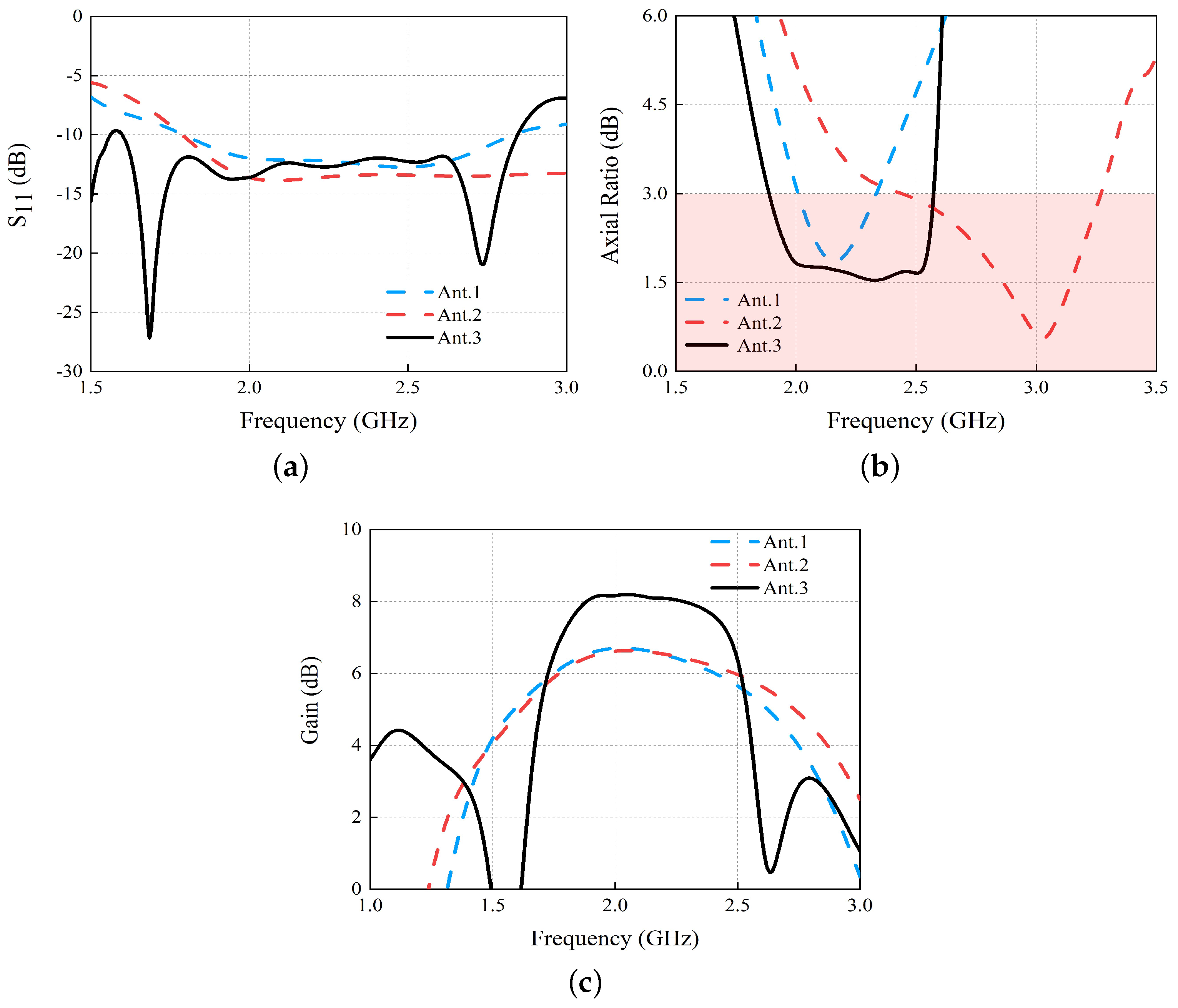
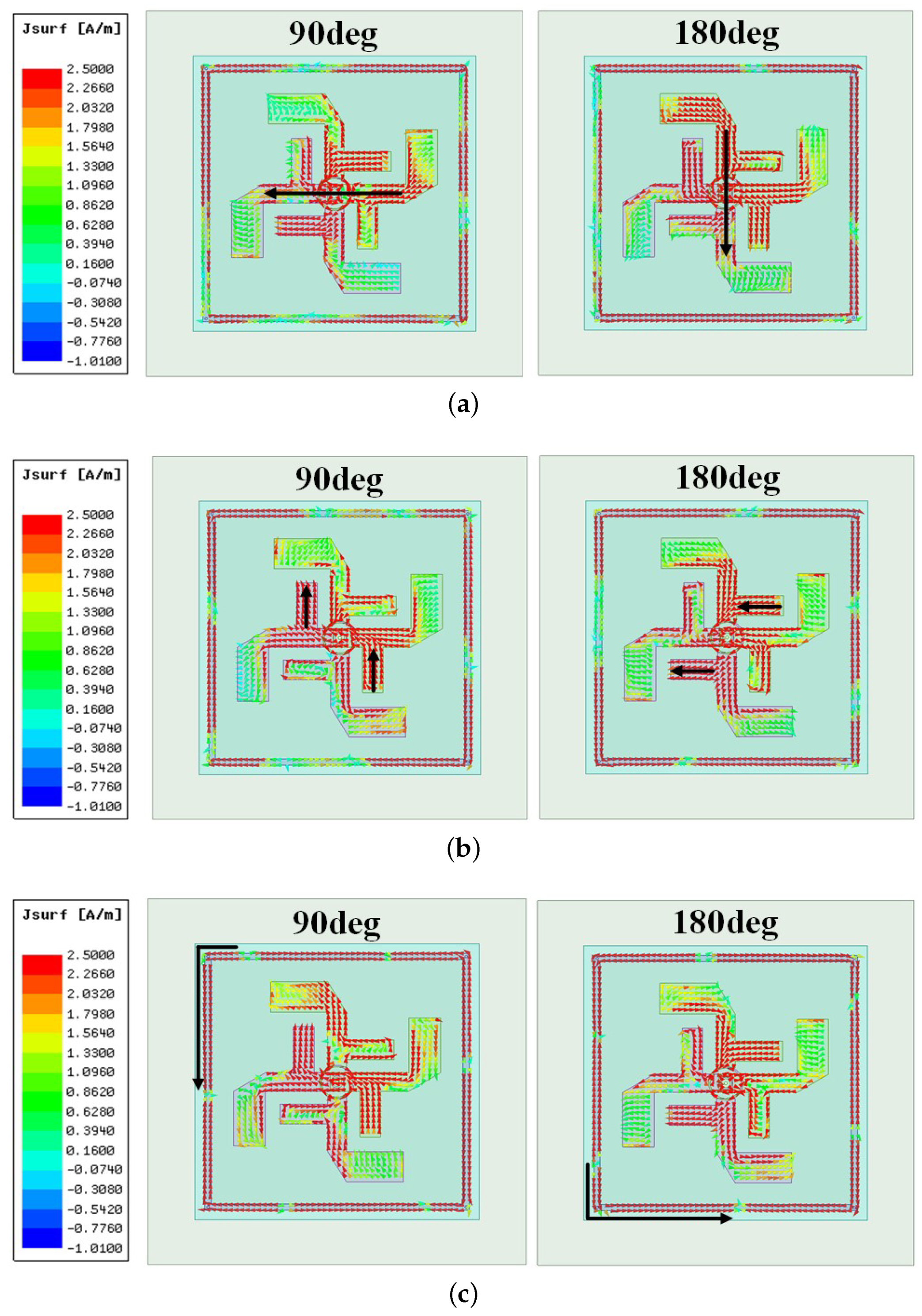
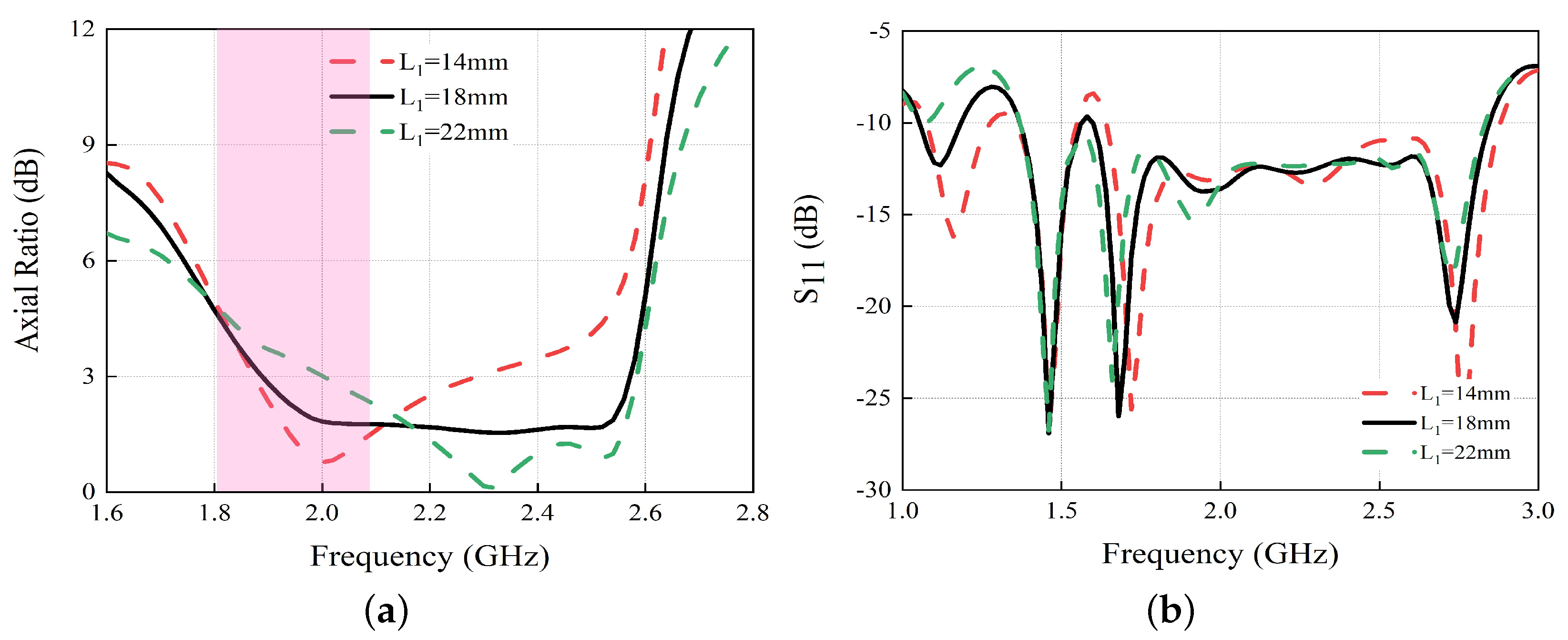

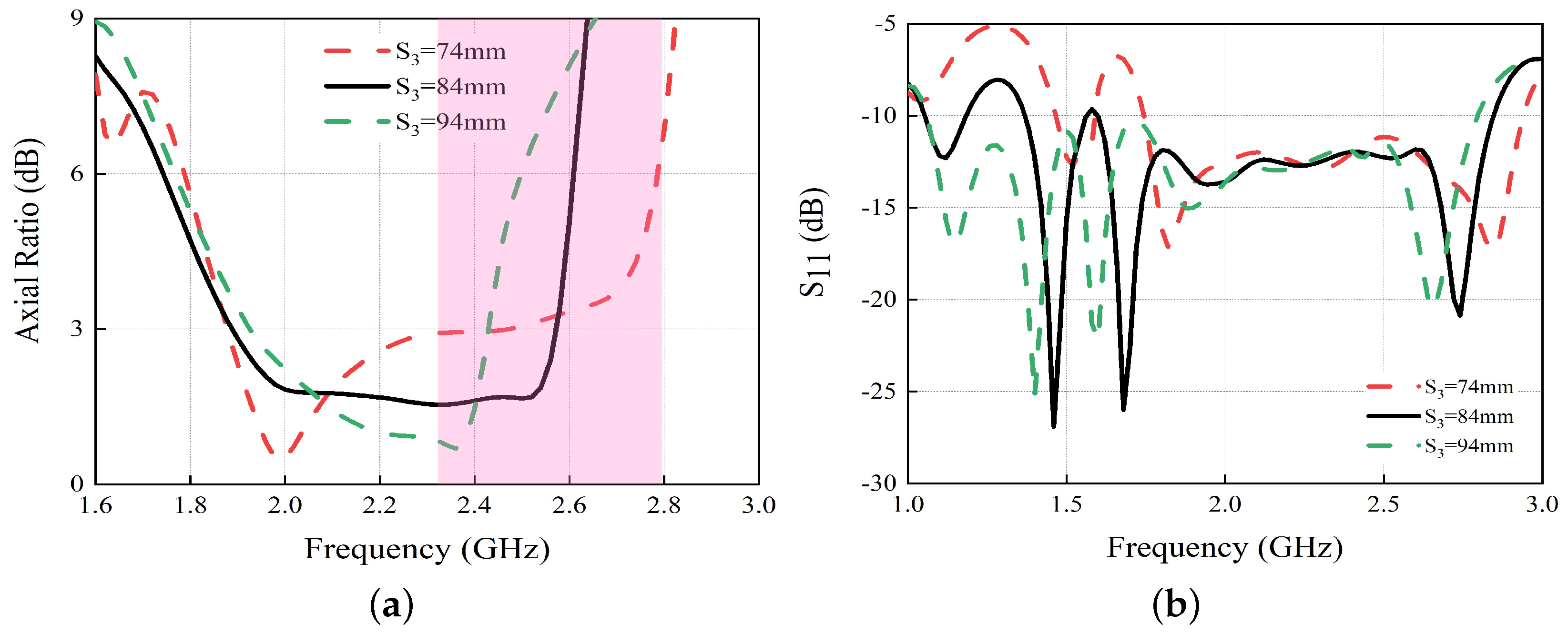
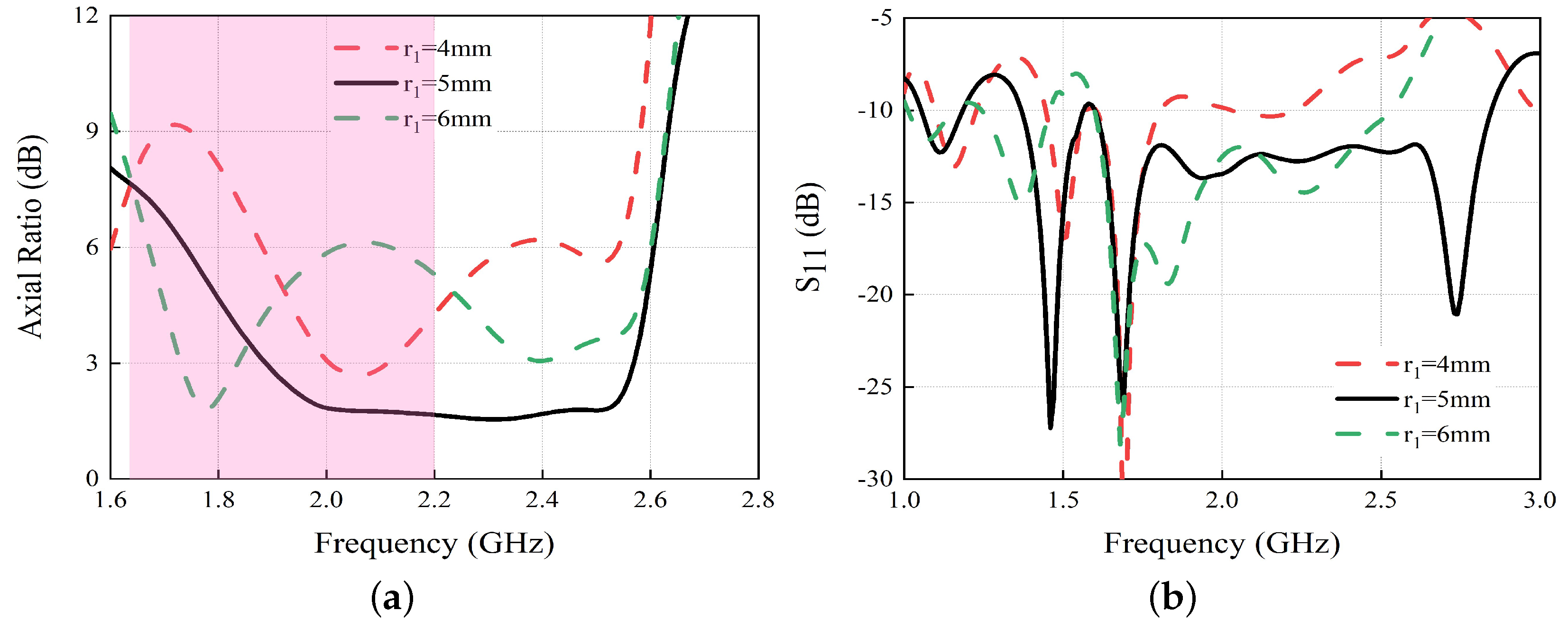
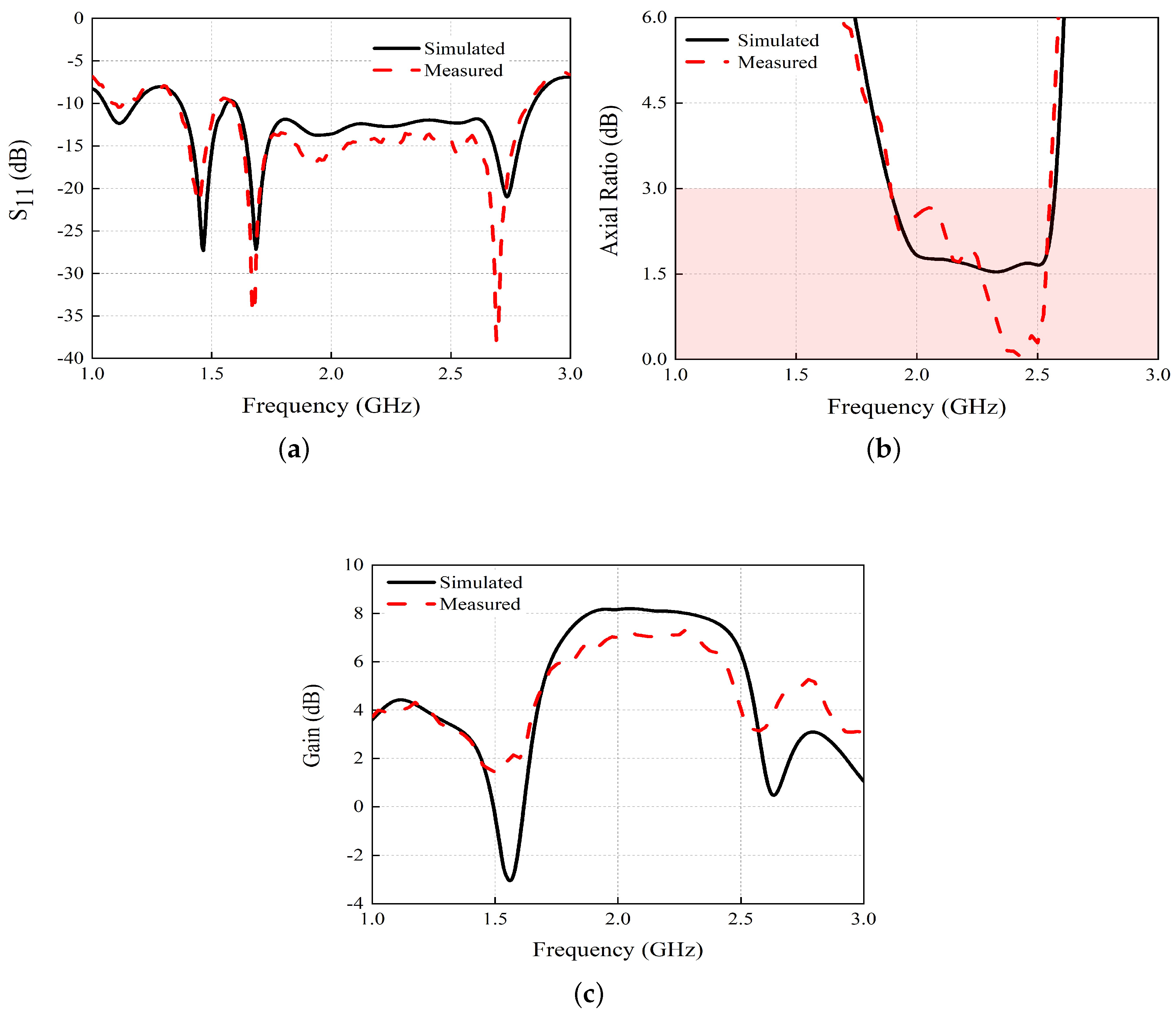

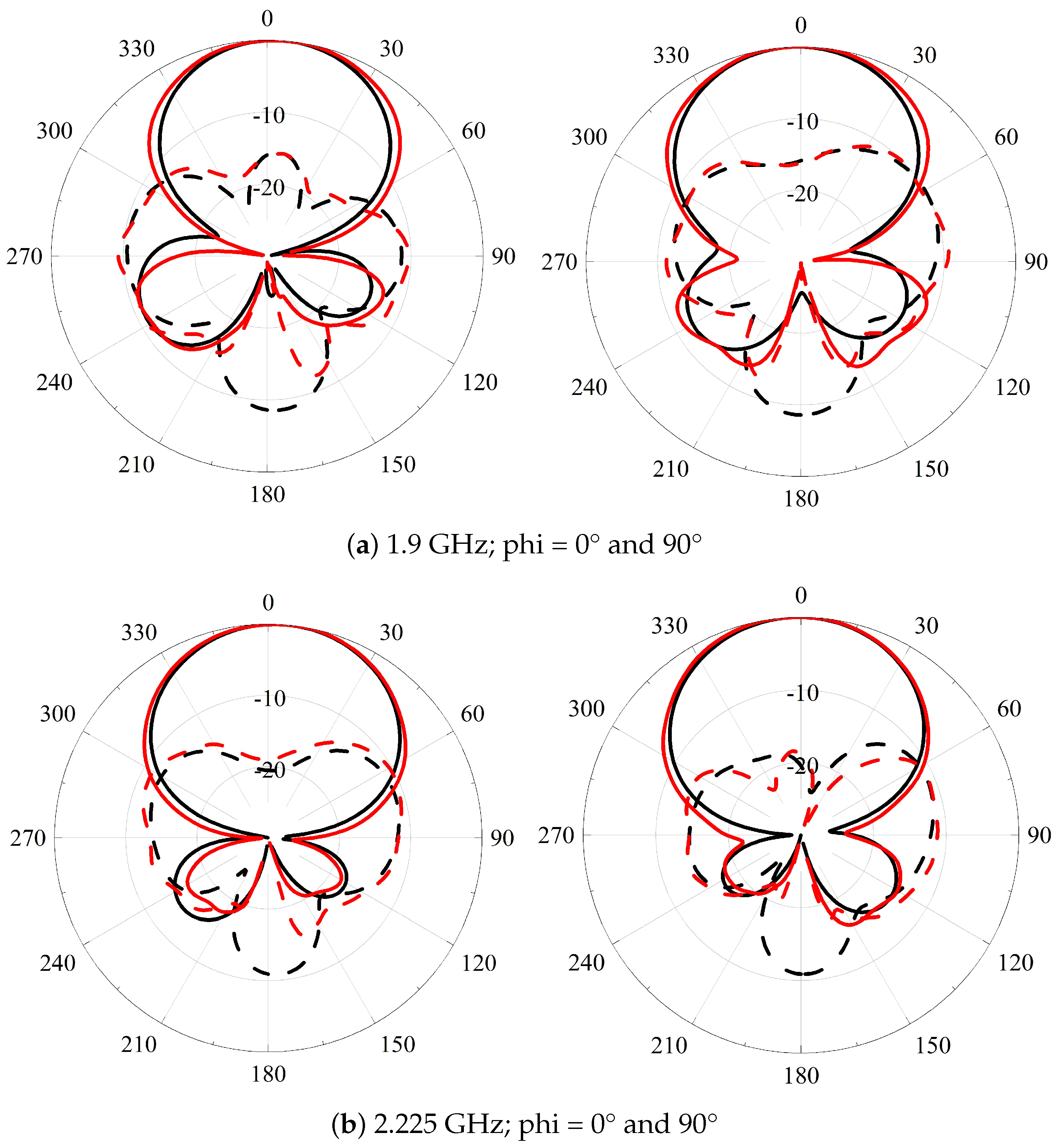
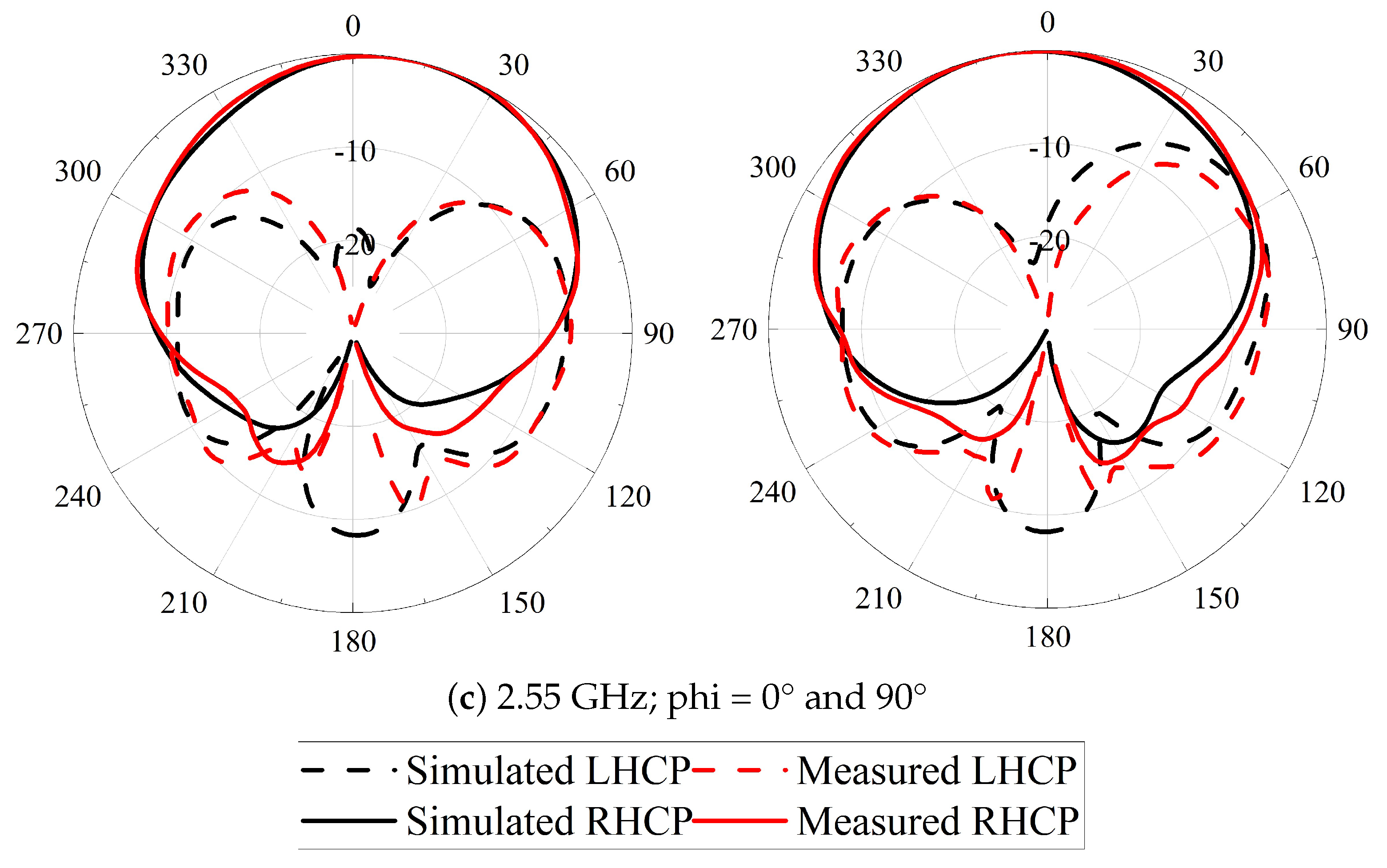
| Ref. | Size () | Type | BW (%) | AR BW (%) | Overl. BW (%) | Ave. Gain (dB) |
|---|---|---|---|---|---|---|
| [11] | 0.36 × 0.36 × 0.2 | cross-dipole | 50.2 (1.99–3.22 GHz) | 27 | 53.7 | 6.8 |
| [12] | 0.77 × 0.77 × 0.14 | cross-dipole | 50.5 (0.8–1.34 GHz) | 26.4 | 52.2 | 8 |
| [13] | 0.65 × 0.65 × 0.1 | cross-dipole | 47.3 (1.81–2.93 GHz) | 25.3 | 53.4 | 7 |
| [14] | 0.37 × 0.37 × 0.14 | cross-dipole | 31.6 (2–2.75 GHz) | 23.2 | 73.4 | 7.1 |
| [15] | 0.68 × 0.68 × 0.21 | cross-dipole | 64.6 (2.05–3.67 GHz) | 22.89 | 35.4 | 7.6 |
| [16] | 0.42 × 0.42 × 0.12 | dipole feed network | 93 (1.56–4.27 GHz) | 80.7 | 89.7 | 5 |
| [17] | 0.49 × 0.49 × 0.12 | patch circle ring | 100 (0.95–2.85 GHz) | 85.7 | 85.7 | 4 |
| [18] | 1 × 1 × 0.06 | patch SIW | 20 (10.87–3.275 GHz) | 6.4 | 0.32 | 6 |
| [19] | 0.53 × 0.35 × 0.005 | dual-feed dipole | 40 (1.6–2.40 GHz) | 27.1 | 67.8 | 0 |
| [20] | 0.96 × 0.96 × 0.03 | all mental patch | 12.2 (1.44–1.62 GHz) | 6.9 | 56.6 | 3 |
| Pro. | 0.64 × 0.64 × 0.03 | cross-dipole | 55.2 (1.60–2.85 GHz) | 29.2 | 52.9 | 7.5 |
Disclaimer/Publisher’s Note: The statements, opinions and data contained in all publications are solely those of the individual author(s) and contributor(s) and not of MDPI and/or the editor(s). MDPI and/or the editor(s) disclaim responsibility for any injury to people or property resulting from any ideas, methods, instructions or products referred to in the content. |
© 2024 by the authors. Licensee MDPI, Basel, Switzerland. This article is an open access article distributed under the terms and conditions of the Creative Commons Attribution (CC BY) license (https://creativecommons.org/licenses/by/4.0/).
Share and Cite
Liao, C.; Liu, W.; Lin, X. The Aesthetics and Pragmatics of Symmetry in High-Gain and Wideband Circularly Polarized Antenna Design. Symmetry 2024, 16, 1016. https://doi.org/10.3390/sym16081016
Liao C, Liu W, Lin X. The Aesthetics and Pragmatics of Symmetry in High-Gain and Wideband Circularly Polarized Antenna Design. Symmetry. 2024; 16(8):1016. https://doi.org/10.3390/sym16081016
Chicago/Turabian StyleLiao, Chunping, Wenyong Liu, and Xianjing Lin. 2024. "The Aesthetics and Pragmatics of Symmetry in High-Gain and Wideband Circularly Polarized Antenna Design" Symmetry 16, no. 8: 1016. https://doi.org/10.3390/sym16081016





